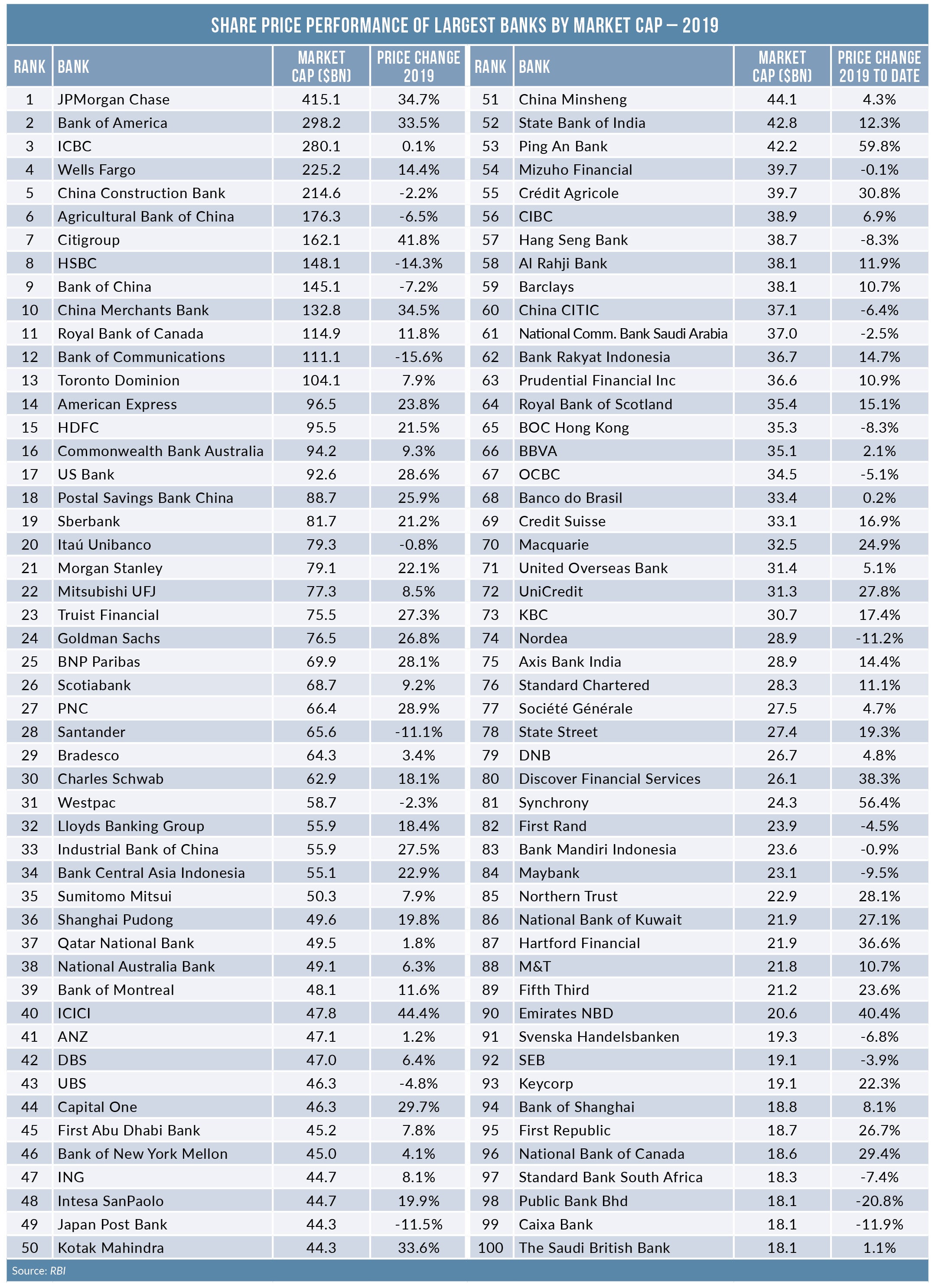Douglas Blakey looks at the share price performance of the largest banks. With 75 of the world’s largest 100 banks by market cap posting a rise in their share price in 2019 it is a strong year for the sector. But some big names drop out of the top 100
So by the crude measure of share price performance, 2019 goes down as a strong year for the banking sector.
In particular, 2019 is an outstanding year for shareholders in the largest US banks.
Citigroup leads the way among major US lenders with its share price ahead by 41.8%.
But the world’s largest two banks by value, JPMorgan Chase and Bank of America also enjoyed a stellar 2019.
Both Chase and Bank of America share prices are ahead by more than 33%.
How well do you really know your competitors?
Access the most comprehensive Company Profiles on the market, powered by GlobalData. Save hours of research. Gain competitive edge.

Thank you!
Your download email will arrive shortly
Not ready to buy yet? Download a free sample
We are confident about the unique quality of our Company Profiles. However, we want you to make the most beneficial decision for your business, so we offer a free sample that you can download by submitting the below form
By GlobalDataMoreover, shareholders at US super-regional banks including US Bank (+28.6%), PNC (+28.9%) and Fifth Third (+21.2%) have enjoyed strong years.
And it is this sector that witnessed arguably the most interesting retail banking M&A activity of the year with the birth of Truist. The result of the merger of BB&T and SunTrust, Truist is now the 24th largest bank by market cap ($75.5bn).
The combined BB&T/SunTrust has assets of $470bn, $327bn in deposits and loans of $303bn. All eyes now turn to its success or otherwise in hitting its cost-cutting targets.
In particular, Truist will be moving forward with a branch consolidation plan. By branches, BB&T and SunTrust ranked as the sixth and tenth largest US banks.
BB&T ended the first half of 2019 with 1,791 outlets, down 180 on the year. SunTrust had 1,159 units, down 84 on the year.
Canada’s big six: all post share price gains
Elsewhere in North America, the major Canadian lenders are again in positive territory.
RBC (+11.8%) and Bank of Montreal (11.6%) enjoy double digit increases with Scotiabank ahead by 9.2%, TD up by 7.9% and CIBC +6.9%.
Arguably, National Bank of Canada, the smallest of the big six Canadian lenders merits a special mention. For the first time, NBC ranks in the world’s largest 100 banks by value, with its share price +29.4%.
UK: Double digit rises at Lloyds, RBS, Barclays, StanChart
Once upon a time-pre the 2008 crisis-Royal Bank of Scotland featured prominently in the top 10 banks by market cap.
These days RBS limps along outside the top 50. But along with its peers Barclays and Lloyds, 2019 represents a welcome upturn for its followers.
Lloyds moves from the 37th largest bank by value a year ago to 31st with its share price +18.4%.
RBS inches up from 67th to 64th on the back of a 15.1% rise in its share price. Barclays, +10.7% for the year to date, brings off a UK treble, now ranking 59th.
Standard Chartered continues its recovery post-crisis with its share price +11.1%. UK challenger Virgin Money (the rebranded former Clydesdale) has had a tricky year but is also in positive territory, up by 6.7%.
For well documented reasons, the UK’s Metro Bank endured a torrid year. The year kicked off with a Metro Bank share price of £17.18. It was to peak at £22.02 in late January. There then followed the news that Metro had wrongly classified £900m of loans. It ends the year at around £2.00 and down 88% for the year for market cap of only £350m.
The top 100: new entrants
The world’s largest 100 banks by value contain a number of notable new names.
For example, exactly one year ago on 6 December 2018 Emirates NBD ranked 117th largest bank by market cap. Today, it ranks 91st with its share price ahead by +40% for the year.
US regional lender Keycorp also features in the top 100 this year, up 22.3%. Similar comments apply to Hartford Financial, up 36.6% while Synchrony tops all of its regional peers, up 56.4%.
The top 100: notable names missing
One year ago, Deutsche Bank limped into the top 100 in 99th place. Deutsche shareholders have endured another frustrating year, its share price down by 9.4% for a market cap of $14.9bn.
Deutsche now languishes as the 120th largest bank by value. Also in Germany, 2019 represents another challenging year for Commerzbank, another former fixture in any top 100 banks by market cap ranking. Its share price is down by 4% for a market cap of $7.8bn.
Elsewhere in Europe, notably in Scandinavia, there is much red ink. Swedbank (-37.6% for a market cap of $14.8bn) and Danske (-27.1% for a market cap of $12.2bn) have endured years to forget.
By contrast, European banks to note outside the top 100 include Hungary’s OTP. The OTP share price is up by 27.9% for a market cap of $14.1bn.
Australian resistance
Lastly, the share price performance of the major Australian banks merits a mention. Notwithstanding a difficult year for the Australian banks – in particular the highly damaging revelations arising from the Royal Commission, the share price performance of the sector is resilient, as discussed elsewhere in this issue (see pages 18-19).
Commonwealth Bank of Australia’s share price is up by 9% with National Australia Bank +6.3% and ANZ up 1% with only Westpac, down by 2.3% in negative territory.








